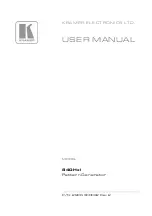
2.0 Functional Description
Fusion 878A
2.18 Digital Audio Packetizer
PCI Video Decoder
2-56
Conexant
100600B
2.18.4 Audio Packets and Data Capture
Audio samples are grouped into a line packet of length ALP_LEN bytes. The
audio line packets are grouped to form an audio field packet of length AFP_LEN
audio lines. Thus, the number of data bytes in an audio field is ALP_LEN ×
AFP_LEN. The line and field concept applied to audio only serves to delimit the
real-time continuous data stream, into packets, that can be monitored for error
conditions. The FIFO status and data flow is below.
When ACAP_EN is set high, the audio capture sequence begins. The first
36-bit word written to the FIFO contains the FM1 packet-mode status code
(DWORD data portion = Don’t Care). The next word written contains 1 DWORD
of audio samples and the SOL status code. Then ALP_LEN/4–2 words are written
with the PXV status code and one audio data DWORD, followed by one more
word of one audio data DWORD and the EOL status code. Each line of audio data
always begins DWORD aligned. Since ALP_LEN has byte resolution, the last
audio data DWORD of the line may contain less than 4 valid bytes as indicated by
the proper EOL(1-4) code. This data is right-justified. The next line starts
DWORD aligned again.
Regardless of where the audio is sourced (A/D, Digital Audio, or Packet
Data), ALP_LEN always controls the proper usage of EOL codes. Thus in the
case of A/D interface where data is presented as 16-bit words, an odd number of
bytes used for ALP_LEN would cause one byte to be lost since this byte would
not be carried into the next line. Similarly for the digital audio interface, which
consists of L,R word pairs, an ALP_LEN not a multiple of four would cause data
to be lost. So it is recommended that ALP_LEN be used with byte resolution for
Data Packet mode, word resolution for A/D mode, and DWORD resolution for
Digital Audio mode.
The audio data samples from the DDF are presented to the DAP as 16-bit
words or 8-bit bytes as determined by DA_SBR. The DAP packs words or bytes
together into DWORDs for writing into the FIFO. Usually, two words are packed
together (little-endian format) into a DWORD to be written into the audio FIFO.
If ALP_LENmod4 equals 2, then the last word of the line for the FIFO will
contain only 2 valid bytes (EOL2). The next 16-bit audio sample will begin the
next line (right-justified, DWORD aligned). Similarly, L,R digital audio word
pairs are packed together (always a DWORD) and written to a common FIFO
location. Data bytes from the packet mode interface are, collected into DWORDs
also, except for the last DWORD of the line which may have fewer than four valid
FIFO Status
FIFO Data
begin Audio Field
FM1
Don’t Care
begin Audio Line
//repeat (AFP_LEN)
SOL
audio DWORD
PXV
audio DWORD
//repeat (AFP_LEN)
EOL(1–4)
audio DWORD or sub-DWORD
end Audio Line
VRO
Don’t Care
end Audio Field
















































